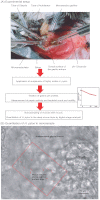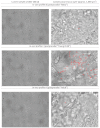Helicobacter pylori colonization critically depends on postprandial gastric conditions
- PMID: 23251780
- PMCID: PMC3524519
- DOI: 10.1038/srep00994
Helicobacter pylori colonization critically depends on postprandial gastric conditions
Abstract
The risk of Helicobacter pylori infection is highest in childhood, but the colonization process of the stomach mucosa is poorly understood. We used anesthetized Mongolian gerbils to study the initial stages of H. pylori colonization. Prandial and postprandial gastric conditions characteristic of humans of different ages were simulated. The fraction of bacteria that reached the deep mucus layer varied strongly with the modelled postprandial conditions. Colonization success was weak with fast gastric reacidification typical of adults. The efficiency of deep mucus entry was also low with a slow pH decrease as seen in pH profiles simulating the situation in babies. Initial colonization was most efficient under conditions simulating the postprandial reacidification and pepsin activation profiles in young children. In conclusion, initial H. pylori colonization depends on age-related gastric physiology, providing evidence from an in vivo infection model that suggests an explanation why the bacterium is predominantly acquired in early childhood.
Figures







References
-
- Suerbaum S. & Michetti P. Helicobacter pylori infection. .N Engl J Med. 347, 1175–1186 (2002). - PubMed
-
- Dooley C. P. et al. Prevalence of Helicobacter pylori infection and histologic gastritis in asymptomatic persons. N Engl J Med. 321, 1562–1566 (1989). - PubMed
-
- Kuipers E. J., Thijs J. C. & Festen H. P. The prevalence of Helicobacter pylori in peptic ulcer disease. Aliment Pharmacol Ther. 9 Suppl 2, 59–69 (1995). - PubMed
-
- Eck M. et al. MALT-type lymphoma of the stomach is associated with Helicobacter pylori strains expressing the CagA protein. Gastroenterology 112, 1482–1486 (1997). - PubMed
-
- Brenner H. et al. Is Helicobacter pylori infection a necessary condition for noncardia gastric cancer? Am J Epidemiol. 159, 252–258 (2004). - PubMed
Publication types
MeSH terms
Substances
LinkOut - more resources
Full Text Sources

